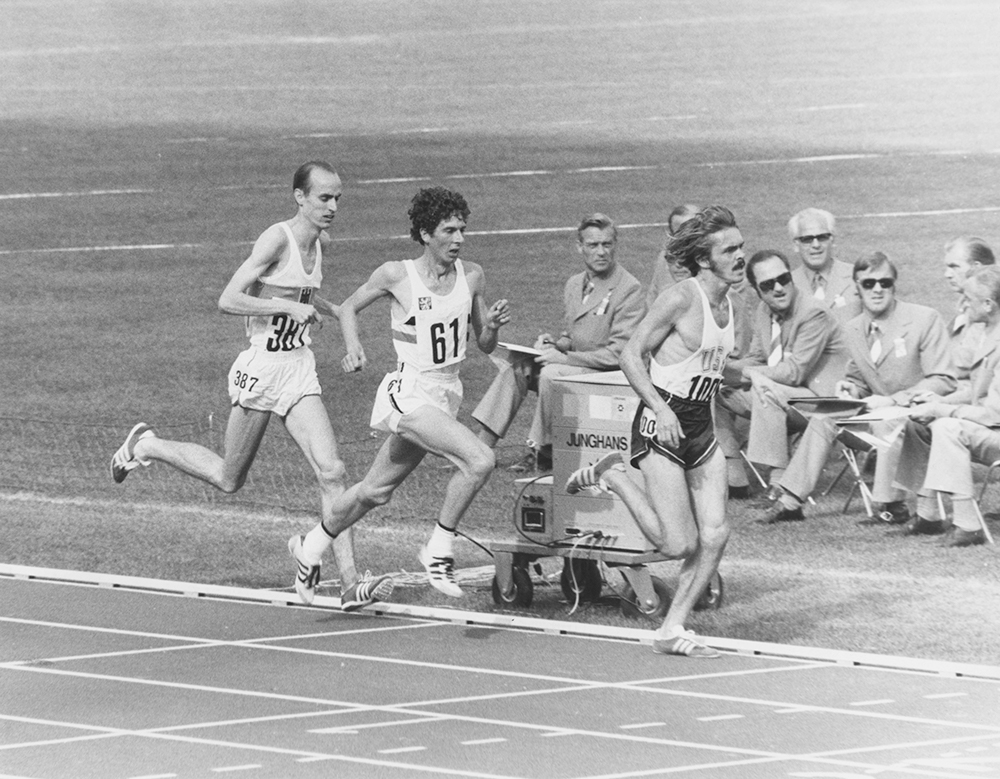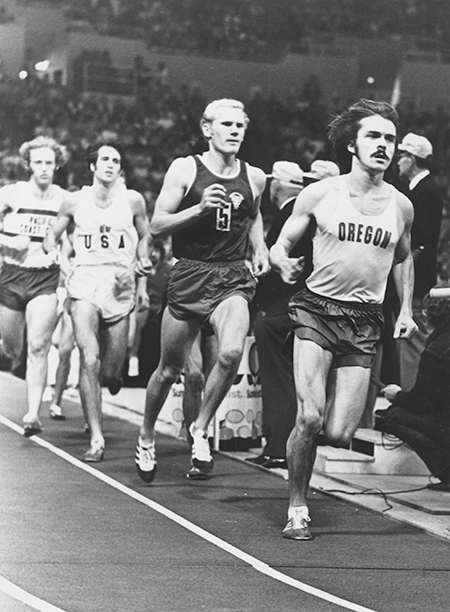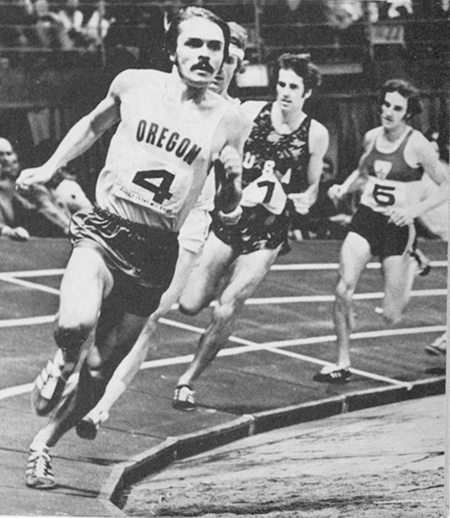
HERE, IN THE NINTH chapter of a long multi-part series, is how we reported the career of Steve Prefontaine in our pages from post-Munich through March of his final year at Oregon. We have taken the liberty of doing some stylistic updatings to mirror our modern protocol and also added an editorial comment or three.
Note that there is no mention of the ’72 NCAA XC Champs, as Pre took a break after the Olympics with plans to use his final season of harrier eligibility in the fall of ’73. You’ll also note that just as in ’70, ’71 & ’72, there’s no NCAA Indoor coverage either, for the simple reason that in those days Oregon didn’t go to that meet.
January 1973: World & U.S. Rankings
[Ed: Pre reached what would be his highest World Ranking ever, No. 4 in the 5000, as he repeated as No. 1 American. He also repeated as No. 6 American in the 1500/mile, and in his first 10K appearance was No. 5 American]

I February 1973: LA Sunkist
Los Angeles, California, January 20—Inches, trackdom’s most precious commodity, paid off big in the Sunkist Invitational, especially for World Record breakers Steve Smith and Al Feuerbach, who wowed the 12,106 fans…
The 2M, the most talent-laden event of the meet, saw Steve Prefontaine run away and hide from the likes of Lasse Viren, Frank Shorter and Marty Liquori to enjoy the greatest applause of the meet. Far from sharp, but stronger than ever, Pre led all the way, establishing open space by the 880 and enjoying a growing 20y margin at the mile. The gap was a full half-lap at the end, reached in a speedy early season 8:27.4, just 1.2 off Shorter’s American Record.
Pre’s quarters were reached in 63.4, 2:07.1, 3:10.6, 4:13.8, 5:16.0, 6:19.3, and 7:24.8. His victory lap was a swift 28 seconds.
Pre later said, “I was sorry Viren wasn’t ready. If someone had pushed me, we could have had a record. My strategy was to make sure the pace didn’t go too slow. I was a little surprised at my performance, considering my injury. This was a very satisfying win—a good way to start the New Year.”
The battles were for the places. Tracy Smith, the ’68 Olympian who continues well on the comeback trail, came close to collaring Liquori, another comebacker, at the finish as both clocked 8:38.8. Peter Kaal barely edged Shorter for 4th even though the 8:40.2 and 8:40.6 times don’t agree. Viren, the victim of dysentery in Brazil, hadn’t the strength to be a contender and wound up 6th in 8:49.0. /Bert Nelson & John Wenos/
I February 1973: Variety Of Records For Feuerbach, Pre, Woods
Portland, Oregon, January 27—Munich Olympians Al Feuerbach and Steve Prefontaine returned to their record-breaking ways with new standards as high jumper Tom Woods racked up a collegiate mark as well, to keep the Oregon Invitational’s 9756 spectators excited…
After spending a fall of “taking it easy,” Oregon senior Prefontaine continued his undercover winning ways with a nifty U.S. Record over 2M. His 8:24.6 was what many of the partisan fans wanted to see, and they voiced their roof-raising approval when he took back the lead for good from Don Kardong with 10 of the 22 laps remaining. Though Pre had led the quarters at 61.5 and 2:06, the former Stanford runner edged ahead for 3:05 and 4:14 splits.
Loss of the lead, and the daring to find just what he could do, spurred Pre back to the front to the delight of the crowd. “I decided I better go, after the half-way point,” the gritty distanceman reasoned. “If I fall apart at the end, then I fall apart.”
The only thing that fell was Frank Shorter’s old U.S. mark of 8:26.2, set 2 years ago at San Diego. Though he was well off Kerry O’Brien’s world mark of 8:19.2 and his outdoor PR of 8:19.4, only O’Brien and another Australian, Kerry Pearce (8:20.6), are quicker indoors than Pre, who now has 3 of the top 6 indoor marks ever. All six have come on 160y tracks. /Don Jacobs/
I February 1973: U.S. Notes
“All of a sudden I’ve become injury-prone,” says Steve Prefontaine. Pre began training again in early November (his “layoff” after the Games consisted of 70-90M per week, not hard), and since then has come up with tendinitis of the left knee, a foot bruise, a pulled groin and a stretched calf…
In the Munich 5000 Pre learned something about tactics. “If the Olympics had been held in Los Angeles,” he relates, “I would have been the only runner who wasn’t disqualified in the 5000. In Europe, you can jostle, push, shove, cut in—we don’t allow any of that, so when we race against them we just don’t know”… Pre recently commented that if he can overcome all his little injuries he may try the steeple in ’73.

II February 1973: Pre Blasts Milers Del Buono, Liquori With 3:59.2
Inglewood, California, February 09—Steve Prefontaine, stepping down from his usual longer distances, led a quality mile field almost from wire to wire to highlight the 14th annual LA Times Indoor Games before a record crowd (16,858). Pre didn’t even know he would be running the mile until 2 days before the meet, when, “My coach decided I needed the speedwork.”
Although he doesn’t consider himself a “real miler,” his 3:56.7 credential from last year made it evident beforehand he wouldn’t be embarrassed. All he proceeded to do was set a fast enough pace (61.1, 2:01.1, 3:01.6) to effectively negate the more renowned kicks of “real milers” Marty Liquori, Henryk Szordykowski, Gianni Del Buono and Byron Dyce. Pre’s 57.6 final quarter and 21.0 last 160y lap actually increased his 1320 margin over Del Buono (58.0 last 440), Liquori (57.7) and Szordykowski (59.2).
The 3:59.2 winning time was the first sub-4:00 clocking of the ’73 season as Del Buono (4:00.0) and Liquori (4:00.3) also exceeded the previous seasonal low (Bob Wheeler’s 4:00.5). Szordykowski’s 4:01.0 moved him to 5th on the yearly list.
Prefontaine was obviously quite pleased with his performance after the race. He stated, “I naturally feel more competent at ‘my distance,’ but now I feel I can run the mile with most people. I seem to be getting more speed the older I get. I didn’t feel that great with half-a-mile to go. It doesn’t feel good when you’re leading all the way. If someone helps with the pace, it’s a lot easier. Then I heard the crowd come to life and I thought, ‘Hell, they’re right on my butt ready to pass me’, so I just dug down and ran as fast as I could!” /John Wenos/
II February 1973: U.S. Notes
After his American record 2M at Portland, Steve Prefontaine said, “I’m always happy with an American Record, but now it’s about time to start getting the bigger ones—some World Records. The last 165y had to be the fastest and easiest I’ve ever run indoors at the end of 2M.”
Incidentally, Pre’s time, originally reported in T&FN as 8:24.8, is in reality 8:24.6. The Data-Timing on the race read 8:24.61, and a recent ATFS decision to round up all manually-operated 1/100th timing devices necessitated such a move. But it turns out that the race was also hand-timed officially in 8:24.6 on ordinary watches, so will stand at that time.
Although he doesn’t run too much indoors, Pre has forged an impressive record on the boards, winning 7 of the 8 2M races he has contested. After an initial loss as a frosh (8:46.8), Pre has rapped off clockings of 8:39.2, 8:31.6, 8:34.4, 8:26.6, 8:26.6, 8:27.4 and 8:24.6. He now owns 4 of the 6 sub-8:30 indoor times by Americans.
I April 1973: Prefontaine Clips US 6M Mark With 27:09.4
Bakersfield, California, March 24—Steve Prefontaine likes Bakersfield in late March. At least, that would seem to be the case, as Pre has chosen a regular spring all-comers affair here to burn off hot record 6M races the past two seasons.
In 72, Pre blazed a 27:22.4 collegiate standard. This time around it was a national record 27:09.4. “I did it again,” he said, “but don’t ask me how.” How was by stringing together miles of 4:36.8, 4:35.0, 4:33.2, 4:31.4, 4:30.6 and a 4:22.4 with a 60.4 last quarter. “I think I could have run close to 27:00 if I’d had any competition,” he said later.
As it was, Paul Geis of the Oregon TC gave him good help for the first half of the race, taking the concurrently run 3M in a PR 13:24.2. That factor would negate Pre’s time as a World Record, as IAAF rules only allow one race at a time. AAU rules contain no such ruling, although there is the possibility of the “unfair pacing” clause being invoked. /Chuck Skow/
[Ed: The day before this race, Bill Bowerman suddenly stepped down as Oregon’s coach, and was succeeded by Bill Dellinger.]
Previously in the Pre Chronicles…
Part 2: The Frosh Year At Oregon
Part 3: The Soph Year At Oregon
Part 4: The Junior Year At Oregon, XC & Indoors
Part 5: “What I’d Like To Do,” by Kenny Moore
Part 6: The Junior Year At Oregon, Outdoors
Part 7: Summer ’72, The Olympic Campaign